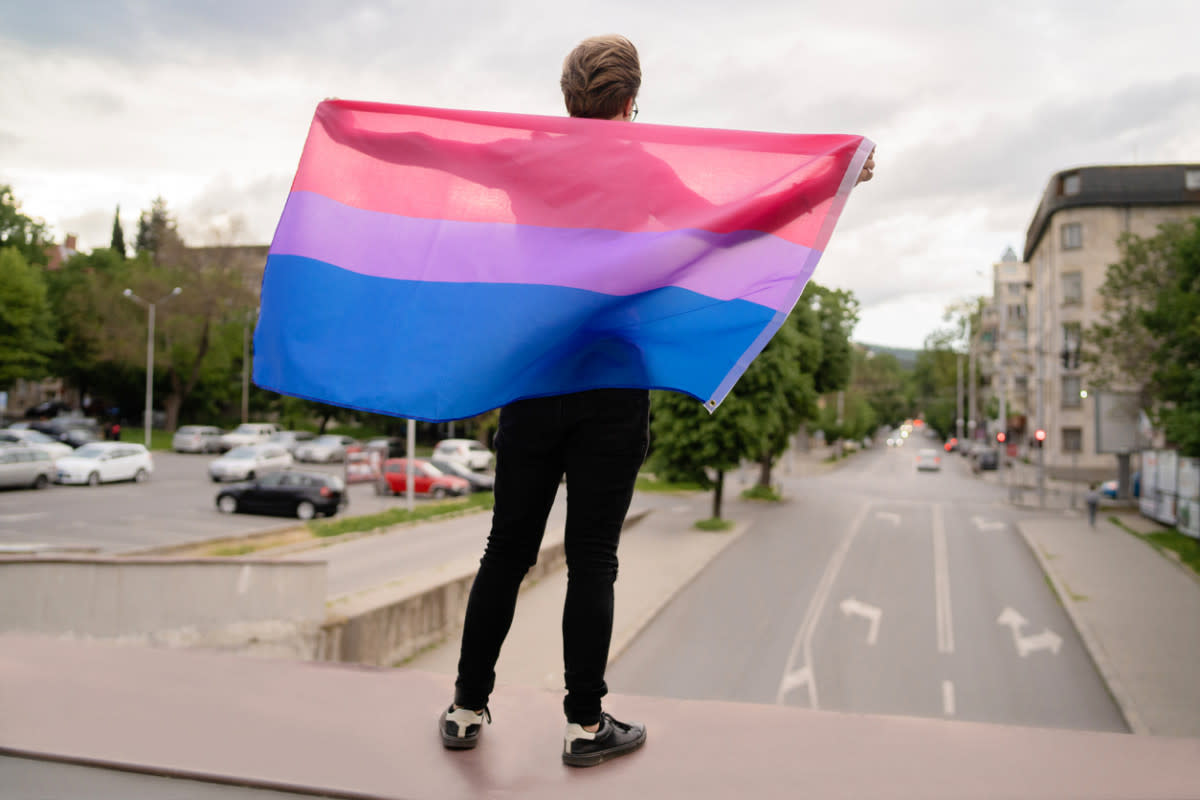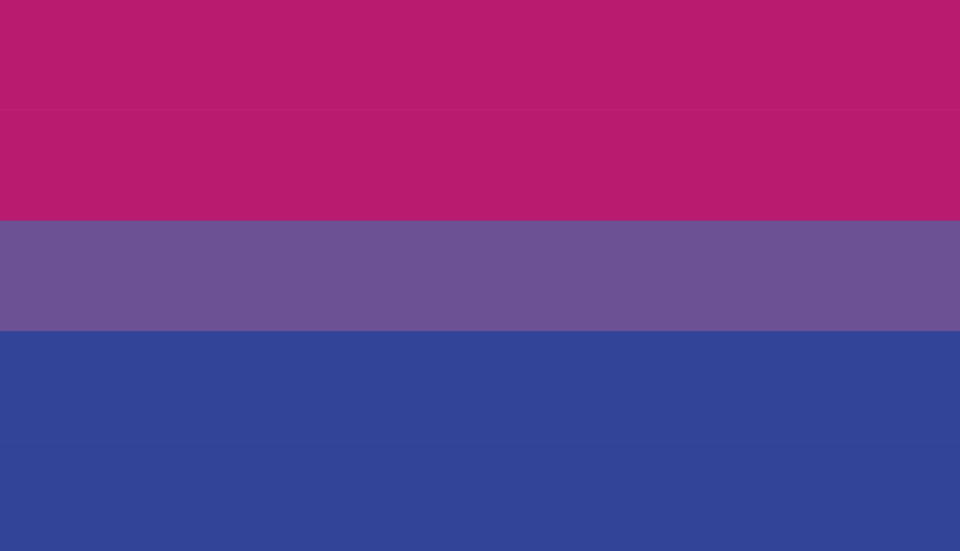What Does the Bisexual Flag Look Like? All You Need To Know About This Pride Flag

Person holding a bisexual flag behind them.
The rainbow flag is probably the most well-known flag of the LGBTQ+ community and one of the best-known symbols that show support. And with National Coming Out Day on Oct. 11, you're probably going to see a lot more Pride flags, including more than just the rainbow Pride flag or even the Progress Pride flag. Nearly every identity and label that falls under the LGBTQ+ community has its own flag, including bisexuals. So, what does the bisexual flag look like?
Considering bisexuality makes up the “B” in “LGBTQ+,” the bi flag is one of the more seen Pride flags. Even if you can’t think of what it looks like right off the bat, once you see it below, you’ll definitely recognize it. But even if you know what the bisexual flag looks like, do you know where it came from or what the colors mean? Read on to find out.
Related: What Does Bisexual Mean? What You Should Know About the ‘Invisible Majority’ of the LGBTQ+ Community
What is the bisexual flag?
We already established that there’s a rainbow Pride flag—pretty common knowledge—but the bisexual flag has far fewer colors.
First off, what does bisexual mean? A bisexual is someone who has the potential to be attracted to more than one gender, or their gender and others. There are different ways that bisexuals can describe their sexuality, but that's typically the general description.
The bi flag—which consists of pink, purple and blue—represents the bisexual and bi+ community who identify as bisexual or under the bisexual umbrella. And before the flag came about, a triangle bi-pride symbol with bisexual colors came first, per Pride.com.
What does the bisexual flag look like?

iStock
As stated above, the bisexual flag has three colors: pink, purple and blue. They’re situated in three horizontal sections, with the top pink section the biggest, the purple section in the middle the thinnest and the bottom blue color being slightly thinner than the pink. There are of course different variations of how thin or thick the colors are on the flag, but that’s pretty standard. And, again, the colors are always the three we mentioned before.
Related: What Does 'Sapphic' Mean? Here’s What the Word Means and How It Relates to ‘WLW’
What do the colors of the bisexual flag mean?
If each color in the rainbow Pride flag means something, you can guess correctly that all three colors in the bi flag mean something significant too.
Pink
According to USA Today, the pink in the bi flag represents same-sex attraction.
Purple
The purple color in the middle is a mixture of pink and blue and represents “more than one type of attraction,” per USA Today.
The creator of the bisexual flag, Michael Page (who we’ll introduce you to in a minute), wrote on his now-archived blog that the purple “pixels of color” blending together from the pink and blue is purposeful and represents how “most bi people blend unnoticeably into both the gay/lesbian and straight communities” in the “real world.”
Blue
The bottom blue color in the bisexual flag represents attraction to the “opposite sex” or genders other than your own (if you’re bisexual, of course).
The bisexual flag colors are great symbols for the bisexual and bi+ communities on their own. In fact, they even inspired the term “bisexual lighting,” which is more a meme than anything, as BBC reported. But that doesn’t stop bisexual viewers from noting when a show, movie or music video uses these specific colors in their lighting or color schemes.
Who created the bisexual flag?
When it comes to who designed the current bi flag, the creator is Michael Page, a Florida-based bisexual activist according to Queer Art History. They reported that Page released the flag’s design on Dec. 8, 1998, on his blog, BiCafe.com (which no longer exists). He came up with the bisexual flag as a way to “create a prominent symbol for the bisexual community.”
Biangles (bi triangles) are a very underappreciated symbol of bisexuality pic.twitter.com/uzQMq7550K
— Балкански Janez ???????????????? (@BalkanAvis) October 15, 2022
As mentioned before, the bisexual flag designed by Page is the first and only bi flag, but it was influenced by the “biangles,” according to INTO. Visually, these are two upside-down triangles—a pink and a blue one—that overlap with the blue triangle’s top left corner to create a smaller purple triangle. INTO reported that the biangles were created by Liz Nania for the Second National March on Washington for Lesbian and Gay Rights in 1987. Similar to the significance of the colors on the bisexual flag, Nania’s biangles also represented things: the pink and blue triangles were representative of boys and girls and the purple represented the Lavender Menace.
Whether you like the biangles or the straightforward bisexual flag, or you want to use the bi flag colors in your own way, the bisexual community has a vibrant way to represent themselves.
Next up, now that you know what the bisexual flag looks like, learn what the lesbian flag looks like and why there are so many variations of it.
